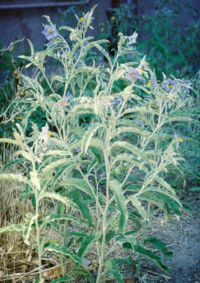
Photo from wikipedia
Invasive alien plant species have impacts on nature conservation, ecosystem services and agricultural production. To identify environmental and human-related drivers of the invasion of Solanum elaeagnifolium (Solanaceae)—one of the worst… Click to show full abstract
Invasive alien plant species have impacts on nature conservation, ecosystem services and agricultural production. To identify environmental and human-related drivers of the invasion of Solanum elaeagnifolium (Solanaceae)—one of the worst alien invasive plants worldwide—we conducted an extensive drive-by survey across the Greek territory (presence/absence data; all national major multilane highways; 12–25% of the remaining road network; driven 3–5 times during 2000–2020). These data were linked in GIS with (i) physical environmental attributes (elevation, climate, soil properties) and (ii) type and intensity of human-related activities (land uses, settlements and road type). Compared to previous records, our survey showed that the range of S. elaeagnifolium increased by 1750% during the last decades, doubling its main distribution centers and reaching higher elevations. Our study revealed that the presence of S. elaeagnifolium is associated with (i) higher maximum temperatures and precipitation in summer and low precipitation in winter, as well as with (ii) soil disturbance related to agricultural activities, settlements and road networks, thus facilitating its spread mainly at low altitudes. Our study elucidates the current invasion pattern of S. elaeagnifolium and highlights the urgent need for its widespread monitoring, at least in the noninvaded areas in Greece that have been surveyed in this study. Preventative measures and integrative initiatives should be implemented quickly, and urgently incorporated into current agricultural, road network and conservation-management regimes.
Journal Title: Plants
Year Published: 2021
Link to full text (if available)
Share on Social Media: Sign Up to like & get
recommendations!